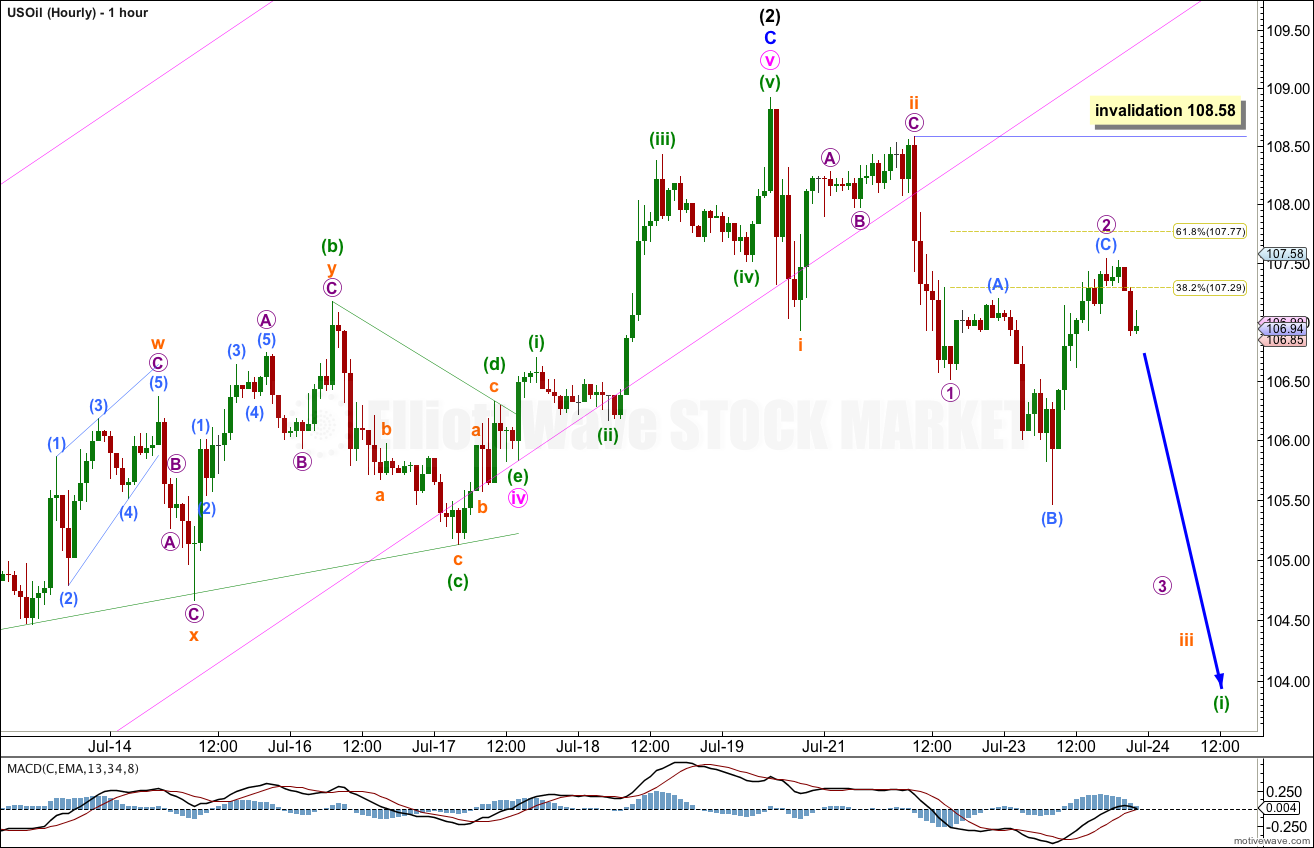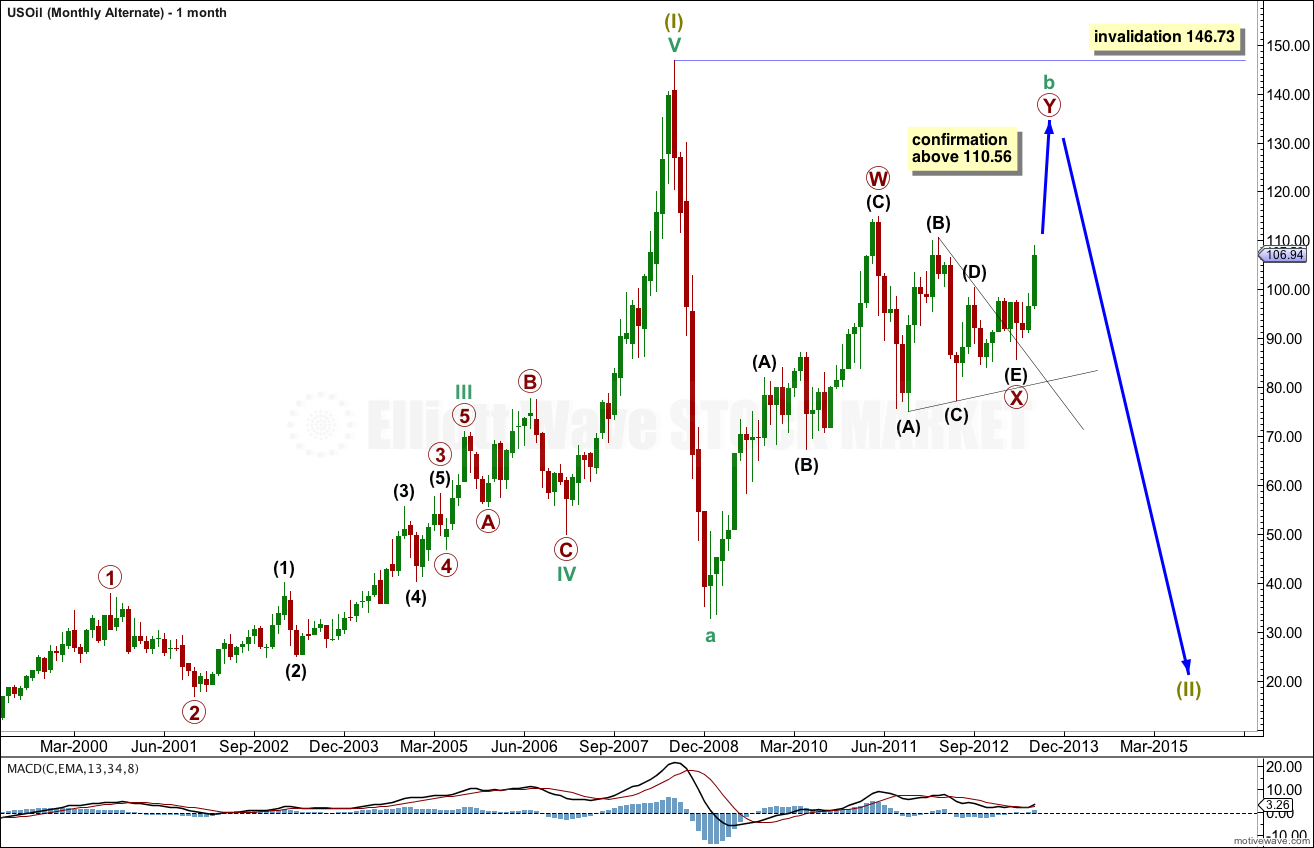Oil has moved higher as expected for the week, remaining just below the invalidation point. If price breaks above 110.56 in the next one to few weeks this wave count will change significantly. I will briefly cover the alternate for this scenario today.
Click on the charts below to enlarge.
Intermediate wave (2) is most likely now a complete zigzag. There is a nice evening doji star candlestick pattern at the high of intermediate wave (2) indicating a trend change.
Within intermediate wave (2) minor wave C has no Fibonacci ratio to minor wave A.
Ratios within minor wave C are: minute wave iii has no Fibonacci ratio to minute wave i, and minute wave v is just 0.06 longer than 0.382 the length of minute wave i.
When the wide parallel channel containing intermediate wave (2) is breached then we shall have trend channel confirmation of this trend change.
Within intermediate wave (2) minor wave 2 may not move beyond the start of minor wave 1. This wave count is invalidated with movement above 108.92.
The structure within intermediate wave (2) may again be considered complete. Price did not move lower as expected to complete minute wave iv last week, it moved sideways to complete a triangle. Within the triangle on the five minute chart minuette wave (e) itself subdivides nicely into a contracting triangle.
There is perfect alternation between minute waves ii and iv; minute wave ii was a deep sharp zigzag, minute wave iv is a time consuming sideways moving shallow triangle.
The channel drawn about the impulse of minor wave C is now very clearly breached indicating intermediate wave (2) is probably over and intermediate wave (3) has likely just begun.
Ratios within minute wave v are: minuette wave (iii) is just 0.01 short of 2.618 the length of minuette wave (i), and minuette wave (v) is exactly 1.618 the length of minuette wave (i). With these remarkably good Fibonacci ratios I am confident this labeling of minute wave iv triangle and minute wave v impulse is correct.
Within the new downwards movement we do not have a clear five down. This movement so far does not subdivide into a leading diagonal because the first wave down labeled subminuette wave i itself subdivides into a diagonal on the five minute chart.
Within subminuette wave iii if micro wave 2 were to move higher it may not move beyond the start of micro wave 1. This wave count is invalidated at minute wave degree with movement above 108.58.
Alternate Monthly Wave Count.
If price moves above 110.56 in the next week this is the wave count I would use.
It is possible that cycle wave b is not over and is completing a double zigzag, with primary wave X within it a contracting triangle.
The triangle of primary wave X does fit, in that all the waves within it can be seen as threes, but it does not have a very typical look for a contracting triangle. The overshoot of the B-D trend line within intermediate wave (E) looks strange. For this reason I would judge this wave count to have a low probability. I would only consider it seriously if it was confirmed with price movement above 110.56.
If this wave count is confirmed we should expect a continuation of upwards movement from oil for some months yet. There is not normally a Fibonacci ratio between subwaves W and Y within doubles, and so a target for primary wave Y to end could only be calculated when intermediate waves (A) and (B) within it are complete.
Cycle wave b may not move beyond the start of cycle wave a. This wave count is invalidated with movement above 146.73.




Hi Lara,
Is there any chance you can do a quick update on oil after today’s large move?
I do not see the need for this, it did exactly as my preferred main wave count expected.
Interesting analysis.
Which is best to short: USO, OilB, OIH, or XLE ?
I am not a registered investment advisor and cannot answer your question.
I provide weekly analysis of US Oil from an Elliott wave perspective in an effort to help others learn how to learn to apply Elliott wave to a market, and to help others with their wave count for this specific market.
Hi Lara,
I don’t understand your comment about it cannot be a leading diagonal because suminuette wave 1 is itself a diagonal?
Subwave 1 of a leading diagonal cannot be a diagonal. It can only be a zigzag or an impulse. Those are the only two structural options for wave 1 of a leading diagonal.
This first wave down is a diagonal. It is not a zigzag or an impulse. Therefore it cannot be the first wave of a diagonal one degree higher.
Does that make sense?
Lara,
can you please refer me to the right place in EWP where it talks about leading diagonals and the fact that wave 1 cannot itself be a diagonal?
Sure.
page 88: “waves 1,3 and 5 of a leading diagonal usually subdivide into zigzags but sometimes appear to be impulses”